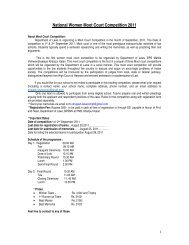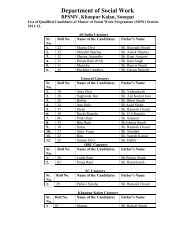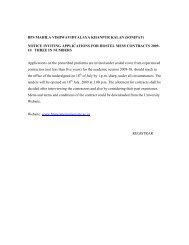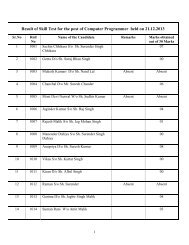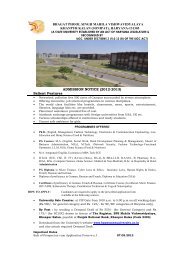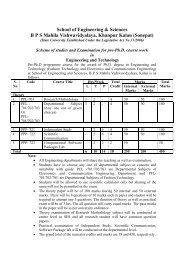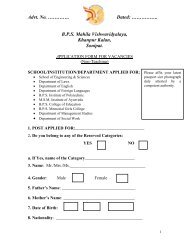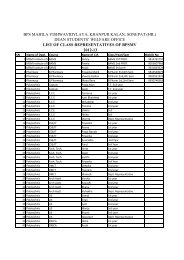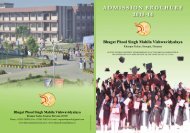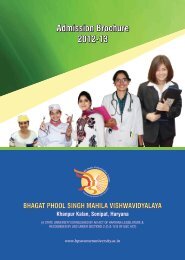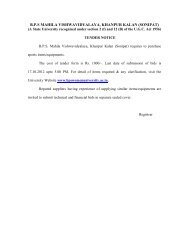Ordinance and Syllabus - Bhagat Phool Singh Mahila ...
Ordinance and Syllabus - Bhagat Phool Singh Mahila ...
Ordinance and Syllabus - Bhagat Phool Singh Mahila ...
You also want an ePaper? Increase the reach of your titles
YUMPU automatically turns print PDFs into web optimized ePapers that Google loves.
Paper Code: BPL-205Pharmacognosy-II (Pharmacognosy-II)L -- T -- P Total Credits: 044 -- -- Total Marks: 100External Marks: 50Internal Marks: 50Paper Objectives: The study of Pharmacognosy is to give knowledge about crude drugs,their cultivation, evaluation <strong>and</strong> use etc. Different methods used for extraction <strong>and</strong>purification of crude drugs from different plant <strong>and</strong> animal source. The study includesmedicinal plants of Pakistan, their habitat, collection <strong>and</strong> biological source of the drug.Allergens <strong>and</strong> allergenic preparations, enzymes, plant growth hormones as well as pesticides<strong>and</strong> poisonous plants with special reference to Pakistan shall are also included. Separation<strong>and</strong> isolation of plant constituents by special techniques like chromatography, ion exchange,electrophoresis <strong>and</strong> high performance liquid chromatography (HPLC) is introduced. Detailedstudy of carbohydrates <strong>and</strong> related products, alkaloids, volatile oils, fixed oils, tannins,glycosides, etc., is included. The students know the Unani system of medicine, phytopharmacology,Traditional Medicine <strong>and</strong> Alternative System of Medicine.UNIT IUNIT IIPhytochemical screening: (a) Preparation of extracts. (b) Screening tests foralkaloids, glycosides, resins, tannins, saponins <strong>and</strong> flavonoids in plant extracts.Study of the biological sources, cultivation, collection, commercial verities,chemical constituents, substituents, adulterants, diagnostic microscopic <strong>and</strong>macroscopic features <strong>and</strong> specific chemical tests of following group of Glycosidescontaining drugs:Saponins: Liquorice, Ginseng, Dioscorea <strong>and</strong> Senega.Cardio-active sterols: Digitalis, Squill, strophanthus <strong>and</strong> Thevetia.Anthraquinones : Aloe, Senna, Rhubarb <strong>and</strong> Cascara.Study of Tannins <strong>and</strong> tannin containing drugs: Study of Tannins <strong>and</strong> tannincontaining drugs like gambir, black catechu, gall <strong>and</strong> myrobalan.Studies of traditional drugs, common vernacular names, botanical sources,morphology, chemical nature of chief constituents, pharmacology, categories <strong>and</strong>common uses <strong>and</strong> marketed formulations of following indigenous drugs:Amla, Shatavari, Aamarg, Gokhru, Shankhpushpi, Gaduchi, Brahmi, Arjuna, Methi,Lehsun, Guggal, Gymnema <strong>and</strong> Neem.Holistic concepts of Drugs administration in traditional systems of medicine.Introduction to Ayurvedic preparations like Arishtas, Asavas, Gutikas, Tailas,Churnas, Lehas <strong>and</strong> Bhasmas.UNIT IIISystematic study of source, cultivation, collection, processing, commercial varieties,chemical constituents, substitutes, adulterants, uses, diagnostic macroscopic <strong>and</strong> microscopicfeatures <strong>and</strong> specific chemical tests of following alkaloid containing drugs:50



